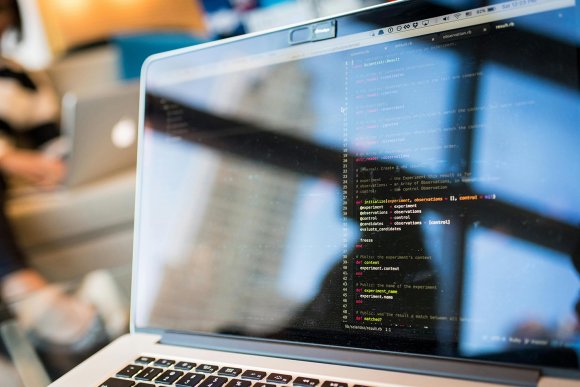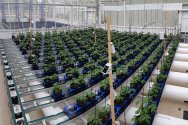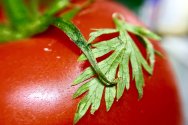Autonomous Cultivation
In greenhouses and vertical farms, many aspects of growing can already be controlled in various ways. So, what if you could develop a fully autonomous cultivation method that could be applied to any indoor cultivation system, anywhere in the world? That’s the ambition of WUR researchers working in the field of Autonomous Cultivation.
What the future of ‘autonomous' looks like
Our world’s growing population and changing climate press us to find the most efficient production methods for our crops. Greenhouse horticulture plays an important role in the year-round production of fresh and healthy fruit and vegetables with a consistently high quality. Cultivation in greenhouses must be efficient in the use of natural resources, economically viable, and produce a high quality product according to tight planning. However, the limiting factor is becoming the availability of sufficient highly qualified staff with knowledge to cultivate a high-quality product and who can oversee all aspects of an efficient production system with minimal use of resources.
We are working towards an autonomous greenhouse in which cultivation is controlled remotely via artificial intelligence, with the help of intelligent sensors and measurements of crop characteristics, and in which automatic systems handle crops to achieve a sustainable and profitable cultivation system.
Our areas of expertise
We bring together all the knowledge needed to make the ultimate future-proof greenhouse a reality: one that requires minimal human labour, minimal inputs in terms of scarce resources like water and nutrients, but maximal efficiency and outputs, and is applicable all over the world.
As the international hub of fundamental knowledge in life sciences, our in-house experts work on plant physiology, sensor technology and vision, machine learning and robotics, and advanced new technologies such as digital twins. State-of-the-art research facilities in Wageningen and Bleiswijk allow us to combine system knowledge, integration, and validation under one WUR roof.
Plant physiology
Plant physiology aims to contribute to the understanding of how plants function, such as the processes that happen in plants in response to changes in their environment and how they adapt to stresses.
Crop health
A full understanding of the development of ecology-based systems for plant health and circular crop production tailored to local conditions on water use and quality, substrate, crop protection, and nutrient use efficiency are essential dimensions to reach the level of full autonomous cultivation.
Cultivation systems and crop management
Optimising plant development over time and ensuring high quality research trials and data, make human involvement necessary. This requires planning, organisation and quality management. The insights generated by large-scale experiments are essential to come to a thorough understanding which technologies can benefit autonomous cultivation systems the most.
Crop Modelling
Environmental factors, such as light, have an effect on crop growth and yield. We use simulation models to research these effects in crops grown in greenhouses and vertical farms.
Greenhouse and climate modelling
The application of physical models is a way to predict the greenhouse climate based on the principles of calculating heat and mass balances. Its components, such as absorption of solar and artificial light, heating, crop transpiration, condensation, and ventilation, follow well-known laws of physics. With computations based on these highly predictable processes, we can define and implement resource-use efficient climate control strategies.
Digital twins
Digital twins use data-integration, artificial intelligence (AI), and machine learning to create a virtual version of a crop. These simulation models are continuously fed real-time information from the actual circumstances in a greenhouse, making it possible to analyse and simulate processes and reactions of plants more accurately. With the help of digital twins, we can better monitor plants and predict future scenarios.
Vertical farming
By growing crops in multi-layer systems, sustainable, efficient and fully controlled cultivation can be done on a relatively small surface. In this way vertical farming can meet the needs of a growing world population. In our unique vertical farming unit in Bleiswijk we investigate how optimal cultivation can be done in controlled areas. We work on the further development of indoor cultivation systems, so that they can be specifically designed for and applied in different
climate zones around the world.
Spectral imaging
Spectral imaging camera systems are able to measure non-destructively chemical compounds, stress- and disease symptoms in plants and many other plant traits invisible to regular RGB cameras. Spectral imaging offers a wealth of information to detect object quality thanks to a whole spectrum analysis available per pixel. Using spectral imaging in combination with models, we can measure the spatial distribution of dry matter content, nitrogen status or sugar concentration, and even lycopene, chlorophyll concentration and much more.
Sensor technology
Non-invasive sensors can measure and monitor a variety of plant traits, plant cultivation and climate conditions in greenhouses. The data provides insights to constantly improve the conditions in the greenhouse and support management decisions. There is a wide range of robust sensors available, and novel sensors and improvements are constantly released.
Robotics and Automation
Robotic systems in greenhouses need to be able to work in a highly challenging environment and deal with complex products that show a lot of variation and change in time (grow or ripen, for example). We design robotic systems combining hardware and software to a functioning robot that can think, sense, and act in such conditions with a key focus on replacing expensive labour for dull, repetitive, and unpleasant tasks.
AI & (3D) imaging
The learning capacity of a robot is a key part of their intelligence. It is possible to discover patterns using the ultra fast novel developments in Artificial Intelligence, for instance in recognising objects in complex environments in images. When given a large number of training data sets, the artificial intelligence automatically learns how to teach itself not only what is in the image but also where it is. The ability of machine learning to handle the high degree of diversity found in natural products is a key strength. Machine learning can also be used, for example, to teach a robot to grip objects or determine yield predictions. We can accurately analyse data to shape models, and turn models into objective information, using computer vision techniques. By assessing characteristics such as product size, surface flaws, leaf area, or stem length, we are able to automatically recognise different plant attributes (phenotyping).
VR / AR & synthetic data
Virtual reality and augmented reality enable researchers and growers to engage in new interactions with data, modelling and digital twins. Synthetic data can be used to train AI models, so accurate reconstructions of plants, fruits, greenhouses, etc. in the
virtual domain are essential to solve the training data bottleneck.
Fruit, bulbs, and flower quality
The timely and accurate monitoring of defects in fruits, vegetables, bulbs and flowers is crucial to guarantee high quality to consumers. However, delivering defect-free products remains a challenge because inspections are still largely performed by humans, which can introduce errors. Could automated systems and smart data collection be key to detecting and predicting the development of defects in a timely manner?
Autonomous control
Growers play an essential role in adjusting the climate to optimal crop growth conditions. They keep a constant keen eye on their
plants throughout their development until harvest, ensuring high yields, profit, and turnover. Autonomous control is the next step in supporting growers to take a step back from this demanding process, enabling them to focus on other aspects of crop production optimisation.








